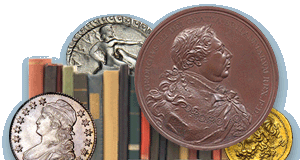
PREV ARTICLE
NEXT ARTICLE
FULL ISSUE
PREV FULL ISSUE
BARTON DISCUSSES COLONIAL NUMISMATICSGreat Bridge Battlefield and Historic Waterways Museum docent and numismatist Doug Barton gave a presentation on colonial numismatics documented in a story for The Virginian-Pilot. Here's an excerpt - see the complete article online. -Editor Doug Barton is a numismatist — a coin and currency collector. He is also a docent at the Great Bridge Battlefield and Historic Waterways Museum in Chesapeake. Barton blends his hobby with his interest in monetary history in a presentation that sheds light on the coins and currency used in American colonies during the Revolutionary War. "During the American Revolution, there was no American money. What was spent most was Spanish reales," Barton said. "When the Jamestown colony was set up in 1607, the Mexico City mint set up by the Spanish had already been running for 71 years," he noted. "The eight-real coin — ‘the piece of eight' — was the main Spanish denomination." In English colonies in America, money was a problem. English minted coins and printed currency were scarce because the English authorities frowned upon sending quantities of silver coins and currency to America in exchange for colonial-produced commodities. From the English perspective, coins and currency made in the colonies were illegal. Simply possessing colony-made coins and currency could lead to arrest and incarceration — or worse. England refused to permit the colonists to mint or print mediums of exchange. American colonists often freely engaged in bartering locally for goods, commodities and services. All transactions, whether barter, accounting write-offs, credit or cash, were carried out in denominations of English moneys — pence, shilling, crown, pound. English coinage was scarce so colonists "pressed into service" any coin or currency available. Foreign coins and currency had to do in the absence of English coinage. Because foreign money came in different values and denominations, a system had to be adopted that was universally agreeable within the colonies. "The Spanish pillar dollars — pieces of eight — that I have here all were actually circulated during the Revolutionary War. There were all kinds of denominations and coins circulating throughout the colonies," Barton said. The Spanish real, Dutch lion daalder, French ecu and British crown were among the coins that were most disseminated in the American colonies. "They finally decided that the best way to value the coins was by the weight of the coin," Barton said. "Most of these coins were worth 1 ounce of silver."
"Their coins circulated and eventually spread out over all of the colonies," Barton said. "There were various Dutch businesses working in Virginia, so they probably helped bring Dutch coinage in here, too." The Dutch lion dollar (Leewendaalder) was a large silver coin minted in the Dutch provinces and later in the Dutch Republic during the 16th-18th centuries with a lion rampant on one side of the coin. It was used by the Dutch to facilitate trade. It was regarded by many as the original silver dollar.
To read the complete article, see:
Wayne Homren, Editor The Numismatic Bibliomania Society is a non-profit organization promoting numismatic literature. See our web site at coinbooks.org. To submit items for publication in The E-Sylum, write to the Editor at this address: whomren@gmail.com To subscribe go to: Subscribe All Rights Reserved. NBS Home Page Contact the NBS webmaster 
|


